This article was updated on June 29th, 2024
Old Dog Vestibular Disease can be triggered by a number of things, including inner ear problems, a collar-related injury, a brain tumor, or a nervous system dysfunction. However, there is often no clear trigger or underlying issue that can be found, and the condition arises spontaneously. Usually, dog vestibular disease resolves itself in the same way.
“Vestibular” refers to someone’s sense of balance and body movement, and it can happen in people as well as dogs, though usually not until the dog is seven years old or older.
The “Disease” in the condition’s name may sound scary, but this is almost always a fairly benign illness, and it is not contagious.
It affects the nerves that co-ordinate the messages between a dog’s eyes, inner-ear, and body. You could say it scrambles them to some degree.
In a nutshell, Old Dog Vestibular Disease affects your dog’s balance.
Being able to balance is a pretty fundamental ability, so losing balance makes life very difficult, The symptoms can look pretty scary, and they must feel awful for your pet friend.
If you’ve ever suffered from a bout of vertigo yourself (or even been really, really, drunk!) you’ll have some idea of how he’s feeling. Luckily, this problem is generally not nearly as serious as it looks, and most dogs make a full recovery, with little to no treatment. In some cases, however, problems can persist.
The condition is also known as Old Dog Vestibular Syndrome, Idiopathic Old Dog Vestibular Disease, Peripheral Vestibular Disease, or even (incorrectly) “Old Dog Syndrome.”
In this article, we will review frequent symptoms and treatment options. We will then share 8 important tips to help your dog and avoid more episodes.
Here’s what you need to know:
Symptoms Of Old Dog Vestibular Disease
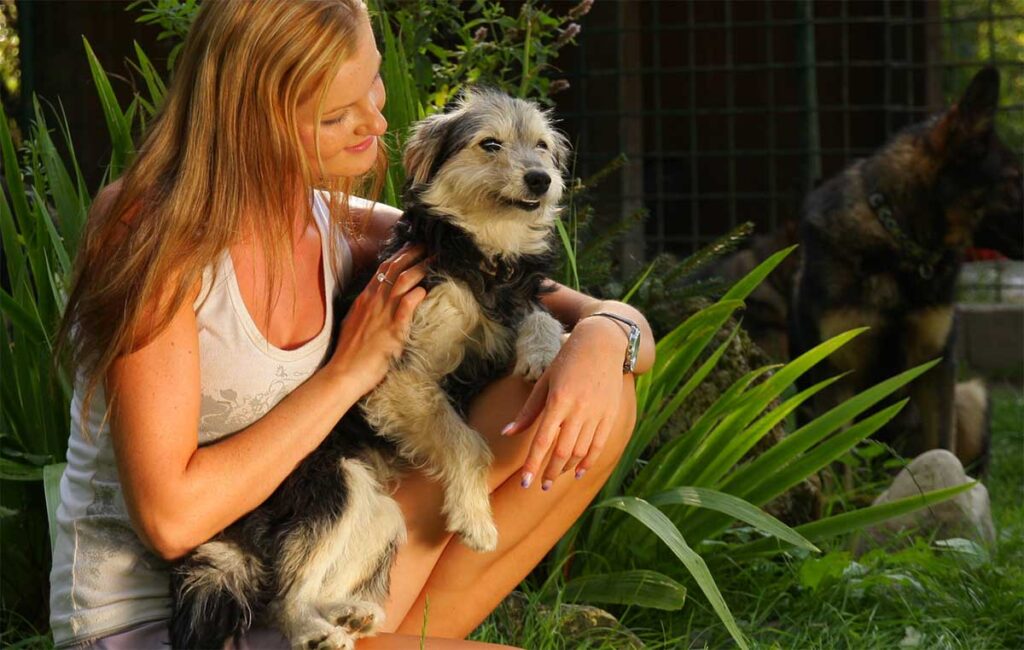
The signs of Old Dog Vestibular Disease come on very suddenly and are dramatic.
This means that it’s easy to panic and think that your dog has had a stroke or has brain damage. Luckily, the odds of either of these happening are much lower.
There are 2 types of Vestibular Disease: Peripheral Vestibular Disease and Central Vestibular Disease.
1. Symptoms of Peripheral Vestibular Disease
- Loss of balance – stumbling, staggering, circling, falling down, rolling around
- Head tilt – head is held oddly, usually tilted at an angle of about 45°
- Erratic eye movements – horizontal, back and forth movement (may roll, too)
- Nausea and/or vomiting
Your dog may not have all these symptoms, but he’s likely to have at least two of them. Loss of balance and nystagmus (the erratic eye-movements) are the most common. However, nystagmus often quickly resolves and can also be overlooked due to confusion with excessive blinking.
2. Symptoms of Central Vestibular Disease
There is another form of this condition called Central Vestibular Disease. This is when the brainstem part of the brain is directly affected, rather than the inner ear or nerves that go to that region. It is more serious and shows slightly different symptoms. Symptoms of Central Vestibular Disease are similar to Peripheral Vestibular Disease, but the nystagmus (eye movements) may not be exclusively horizontal.
These eye movements may change when your dog’s head position changes, may be vertical, horizontal, rolling, or erratic. Only a veterinarian can distinguish between the two by running tests.
Here’s a video that shows what symptoms look like:
Recovery from Peripheral Vestibular Disease
Most dogs will start to improve within 2 to 4 days and will be totally recovered within two to six weeks. This study found that improvement was observed in 71% of cases after a median of 4 days after diagnosis.
The most dramatic clinical signs of vestibular disease are evident within the first 24-48 hours and will usually begin to improve after this point. Depending on the cause of Vestibular Disease, symptoms such as a head tilt and incoordination often disappear within the first 7-14 days.
Some symptoms can persist for months for about 1 out of 3 dogs
There are some cases where a dog may have a permanent head tilt, but generally this isn’t of concern if they are well otherwise. If your dog doesn’t make an improvement within the first week then further investigations are indicated.
The persistence of clinical signs can also be fairly common, with many dogs not recovering completely from an episode of vestibular disease. Vestibular disease may also get worse for some dogs. This study of 188 dogs with vestibular disease tracked the outcome with a median follow-up time of 12 months and found that:
- Head tilt persisted for 34.5% of dogs (Head tilt is not generally a concern if the dog is otherwise well).
- Symptoms of facial paresis persisted for 28.5% of dogs.
- Incoordination when moving (ataxia) persisted for 4.1% of dogs.
Although chances are good that your dog has the Peripheral form of the disease, your dog could also be suffering from Central Vestibular Disease. You can only be sure by taking him to the vet for a proper examination. Only a veterinarian can make the diagnosis.
Causes Of Old Dog Vestibular Disease
Old Dog Vestibular Disease can show up out of the blue for no apparent reason. Vestibular disease isn’t solely a condition which affects only senior dogs, but it is most often seen in dogs who are middle aged or older.
The disease is often idiopathic, meaning it occurs for no known cause. However, your vet may still be able to find an underlying cause, so it is important to do a full medical exam.
Causes of canine peripheral vestibular disease may include:
- Ear infection or inflammation
- Perforated tympanic membrane (also known as the ear drum)
- Viral infection
- Reaction to a medication
- Injury to neck caused by collar, a fall, or some other incident
The causes of the central type of this disease are also more serious and may include:
- Brain damage, trauma or tumor
- Systemic infection or inflammation of the brain
- Fungal infection of the brain
- Tick-borne illnesses
- Toxoplasmosis
- Stroke
Only a veterinarian can make a reliable diagnosis. After an initial exam, your veterinarian will be able to tell you whether more tests are needed.
Treating Peripheral Vestibular Disease In Dogs
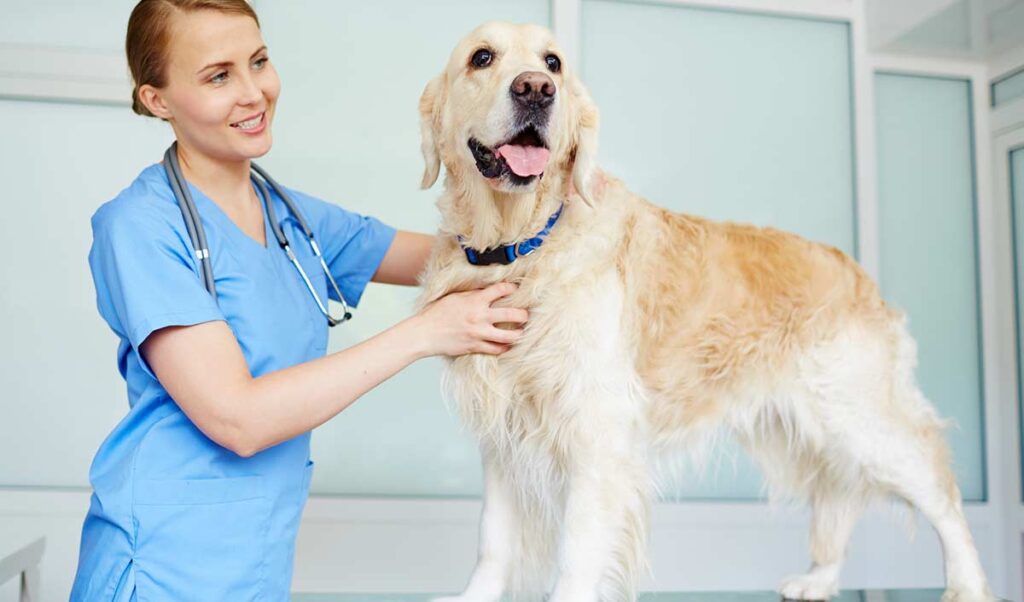
The peripheral form of the disease is often a self-limiting condition. This means that it improves with no intervention if given time.
Most dogs will start to improve within 2 to 4 days, and will be totally recovered within two to four weeks. More severe cases may take up to six weeks to be fully recovered.
Although chances are good that your dog has the Peripheral form of the disease, your dog could also be suffering from Central Vestibular Disease. You can only be sure by taking him to the vet for a proper examination. Only a veterinarian can make the diagnosis.
While the treatment depends on the cause, there are also some things you can do to help your dog cope with the difficulties he’s experiencing.
Treatments:
1. Symptoms of Old Dog Vestibular Disease such as nausea and vomiting can be reduced or controlled by medications prescribed by your vet (similar to the meds you take for motion-sickness).
2. Anti-nausea drugs may be recommended by your vet and these can make your dog feel more comfortable.
3. Anti-inflammatory medications or antibiotics may be prescribed if your senior dog shows signs of an ear infection or problem.
4. Sometimes corticosteroids can help reduce the symptoms of vestibular disease if it is caused by inflammation or swelling.
Obviously, if the examination shows any signs that there’s something more serious going on, then other treatment options for the underlying issue will be needed.
For dogs with simple idiopathic vestibular disease, the rest of the treatment is just supportive care. That means helping your furry friend manage his day-to-day life. This is tricky when he can’t balance properly and his eyes have trouble focusing.
8 Tips to Help a Dog With Vestibular Disease
Here’s what you can do to make your dog’s life easier:
1. Keep your dog quiet and rested
Staggering and stumbling around is scary for your dog, so try to minimize the space he has to move about. If he is used to being crated and is comfy there, this can really help and you can use the crate more than you normally would.
If your older dog is not using a crate, now is not the time to start. Instead, try to confine him to a smaller area.
2. Help your dog walk, eat, drink and potty
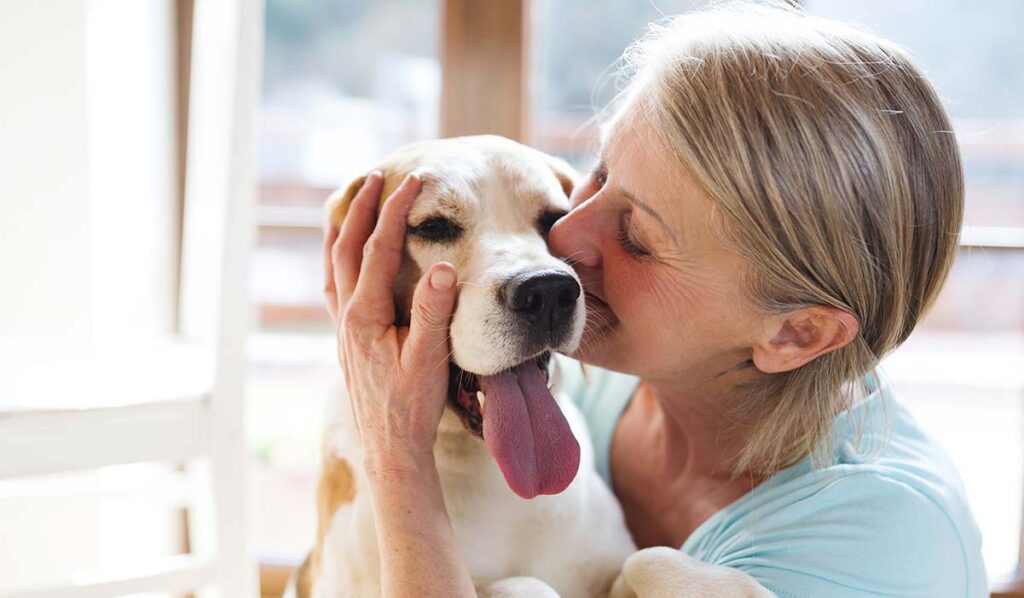
When he needs to go outdoors to relieve himself, help him stay upright. An older dog could really hurt himself if he falls down steps or onto a hard surface or walks into a wall or tree.
Protect him from himself until his balance comes back.
Sometimes using doggie diapers can be helpful (especially at night) because a dog who is dizzy and sick doesn’t notice or respond to potty cues quickly enough.
But don’t completely rely on a belly band or diapers. Make the effort to get your dog to his potty spot regularly and encourage normal potty habits whenever possible.
3. Make their meals more appealing
Consider adding tasty gravy or a canned food to his kibble. Encourage him to eat while lying down if he’ll cooperate. If your dog insists on standing, stay beside him to hold him up.
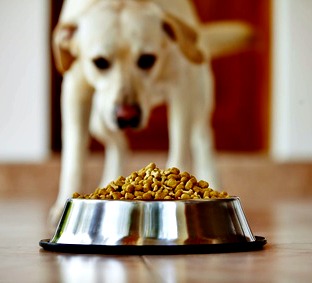
It can be tricky for your dog to eat even if he wants to because his eyes flicker and move involuntarily and make it difficult for him to focus. Some dogs pretty much refuse to eat, or the physical symptoms make it very difficult for them to do so. This stage generally only lasts a few days.
In addition to swaying from side to side and generally struggling to keep their head focused on the food bowl, dogs with vestibular disease often don’t want to eat because they feel sick. Anti-nausea medicines prescribed by your veterinarian can help with this. Learn more with our article How to Feed a Dog with Vestibular Disease.
4. Use supplements to ensure your dog gets the right nutrition
You can try liquid nutritional supplements such as PetAG’s Dyne liquid supplements or Tomlyn’s Nutrical Nutritional Gel, as featured in the two listings below:
- HIGH-CALORIE SUPPLEMENT FOR DOGS & PUPPIES 8 WEEKS AND OLDER - Dyne is a powerful nutritional supplement that provides additional calories to support dogs in all life stages: active, pregnant, lactating, underweight, and senior.
- Nutritional oral gel for dogs who need extra calories and vitamins; ideal for finicky or aging dogs
Both are nutritionally dense and will give your old dog valuable nutrition. Your vet may have these supplements or you can order them online through the links above.
Give a premium vitamin/mineral supplement daily to make sure all body systems have the nutrients they need to function properly. A few examples of these supplements are featured below:
Premium vitamin or mineral supplements on Amazon:
5. Make it easier for them to eat and drink
Drinking poses the same problems, but your dog MUST drink or he’ll get dehydrated, so the same help is needed here. Pedialyte contains vital electrolytes, so try to give your dog a little of the unflavored variety as well as water, if you can (learn more about Pedialyte on PetMD).
6. Use Omega 3 to reduce the chances of further episodes
Although there are no treatments that are guaranteed to prevent further episodes of old dog vestibular disease, there are a few things you can do to help your dog heal completely and possibly reduce the chances of experiencing the whole thing again. Giving an Omega 3 EPA and DHA Fish Oil will help your dog’s body to heal and regenerate to its full potential. We recommend the following from Ascenta: Ascenta Canine Omega3 Supplement, 200ml
We recommend the following from Ascenta:
- The Pure Check logo guarantees that this product has been independently tested and certified for quality , purity and label claims
7. Consider medication if your senior dog won’t or can’t drink or eat
If your senior dog still won’t or can’t drink or eat, then discuss it with your vet. Your vet might want to give Fido some IV fluids to make sure he stays hydrated, or anti-nausea medicine if your dog is feeling nauseous and don’t want to eat.
8. Monitor recovery
The majority of dogs will show signs of improvement within about 72 hours, and be fully recovered within 2-4 weeks. But, if your old dog doesn’t seem to be any better after a couple of days, or he gets worse or shows other symptoms, get him back to your vet asap.
INFOGRAPHIC: 8 tips to help your dog with vestibular disease:
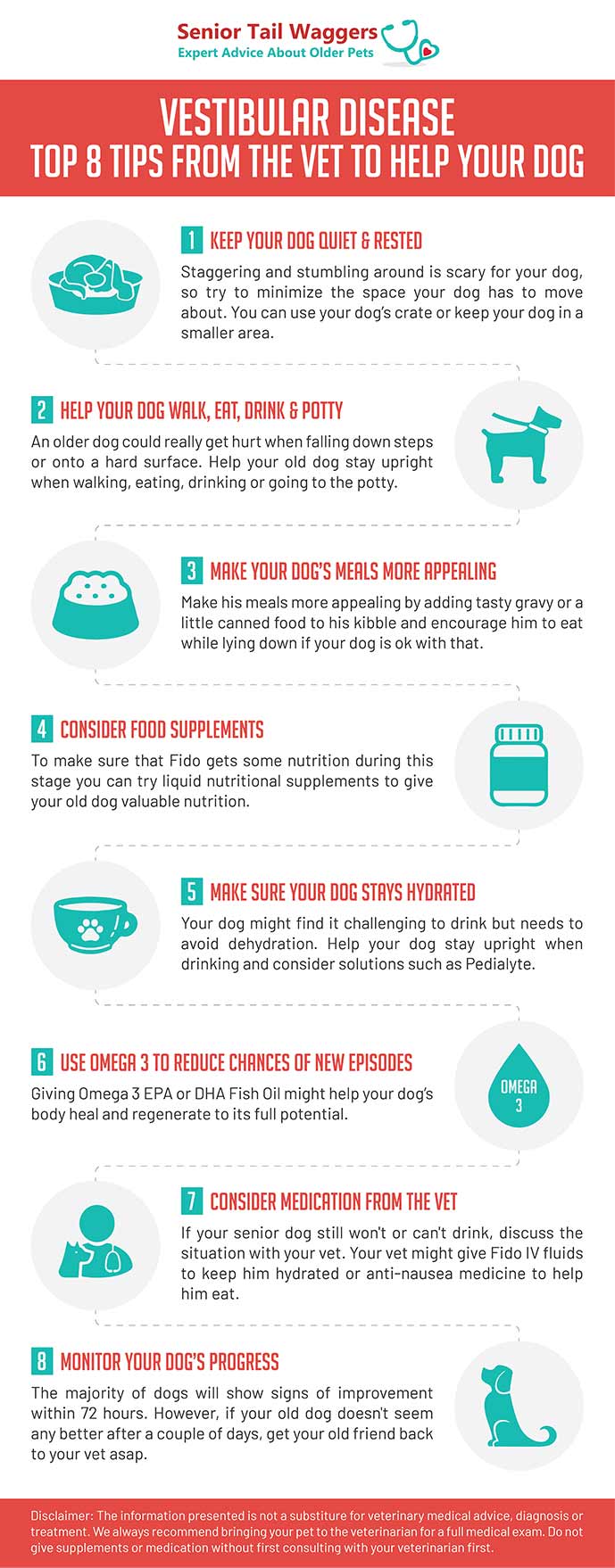
How to Reduce the Risks of More Vestibular Disease Episodes
You should know that once a vestibular disease episode has happened once, your dog has an above-average risk of having another. New episodes are usually similar to the first one in both severity and duration.
Although this isn’t ideal, the good news is that if your dog has another episode, you’ll know what it is right away and won’t feel so panicked. Plus you’ll be able to get him any medications he needs, and know how to help him through those first difficult days.
Although there are no treatments that are guaranteed to prevent further episodes of Old Dog Vestibular Disease, there are a few things you can do to help your dog heal completely, and possibly reduce the chances of experiencing the whole thing again. These include:
- Giving an Omega 3 EPA and DHA fish oil – to help your dog’s body heal to its full potential.
- Giving a premium vitamin/mineral supplement
Additionally, you should know that collar-related injuries can cause vestibular problems, and an accidental pull or jerk could trigger an episode. It’s best to use a harness rather than a collar when walking your dog if they’ve had vestibular disease previously.
Complementary health practices such physiotherapy and acupuncture can all have benefits after the initial recovery period.
Allergies can cause chronic ear infections in dogs which can lead to vestibular episodes. Your vet can help you decide if this might be a problem for your senior dog.
Take things slowly and allow your dog to return to normal activities at their own pace.
How to Feed a Dog With Vestibular Disease
If your dog suffers from vestibular disease, you’ll know how much they can struggle to eat. Many dogs with vestibular syndrome will tilt their head, stumble, circle, and even collapse to the floor.
In addition to swaying from side to side and generally struggling to keep their head focused on the food bowl, dogs with vestibular disease often don’t want to eat because they feel sick. Anti-nausea medicines prescribed by your veterinarian can help with this. You can read the list of changes we recommend to make to make the act of eating as simple as possible for your dog in our article: How to Feed a Dog with Vestibular Disease, by Dr. Alex Crow.
Veterinarian FAQ with Dr. Alex Crow about Vestibular Disease
Owners of dogs experiencing vestibular disease often ask us many questions. We have listed below the top 5 most frequently asked questions with answers from Dr. Alex Crow, Veterinarian.
1. How fast does a dog typically recover from Vestibular Disease?
Most dogs diagnosed with vestibular disease begin to make an improvement within the first 3 days; the most dramatic clinical signs of vestibular disease are evident within the first 24-48 hours and will usually begin to improve after this point.
2. What to do if your dog is not recovering from vestibular disease, or if your dog’s vestibular disease is getting worse?
If your dog shows no signs of improvement within the first 7 days, or if he is getting significantly worse, then the next step is to investigate why this may be. A dog that shows no improvement is suspected to have a more sinister underlying cause for his vestibular symptoms and advanced imaging with CT/MRI scans is likely necessary.
One concern would be a lesion within the brain that had led to the unusual vestibular symptoms seen. A specialist vet is usually required to investigate further so talk to your local vet about a referral if necessary.
3. What should you do with Vestibular Disease recurrence?
The first thing you should do if your dog’s vestibular disease recurs is to take him back to your vet. Depending on how long ago his last vestibular episode was, any recurring symptoms may or may not be related to his previous episode.
If your dog’s vestibular disease is recurring regularly, then the prognosis may be poorer, especially if the time between episodes is shortening. Read our article on the Recurrence of Dog Vestibular Disease.
4. How long can a dog live with vestibular disease?
This will depend on the cause of the vestibular disease. Vestibular disease is simply a result of a more serious condition that could be fatal to your dog:
- Dogs with idiopathic vestibular disease or an ear infection may make a full recovery within 2-3 weeks and continue to live a normal healthy life.
- Dogs that develop vestibular disease due to a trauma or a brain tumor might have a shortened lifespan because of this; exactly how long dogs will live with vestibular disease will depend on the severity of the trauma or tumor.
Learn more with our articles: “How Long Can Dogs Live with Vestibular Disease?” or “Can Vestibular Disease Kill a Dog?“.
5. What are some safe exercises for dogs with Vestibular Disease?
It’s vital that you keep your dog with vestibular disease fit and moving, furthermore re-teaching him to balance himself will be a vital part of their rehabilitation. Only perform exercises with your dog once your vet has given him the all-clear to do so.
If your dog is struggling to stand on his own, then using a sling or rolled up towel under his chest and belly will give him support.
Start in a standing position and build up to 5-10 minutes of standing, trying to release the pressure on the sling as you progress. That way your dog will learn to support his own bodyweight and remain balanced over time.
Once your dog can maintain his balance, gradually start walking with your dog while keeping the sling in place for support.
Core strength will be vital for a dog with Vestibular Disease as it will help him maintain a solid foundation. Have your dog stand up and gently squeeze your dog’s tummy until you feel him tensing his abdominal muscles against you. Repeat this regularly to help build abdominal strength.
Another exercise is to have your dog in a standing position, stand behind him with your hands on his flanks and gently rock your dog side to side. This will help teach your dog to maintain balance whilst a lateral force is applied.
Perform this routine every day until your dog is comfortable walking on his own accord. Stay within his comfort zone and accept that he may never be able to walk completely normally again; it’s all about what compensations you can make as an owner to allow your dog to still live a relatively normal life.
6. Can CBD oil or Benadryl help with Vestibular Disease in dogs?
While there is no firm evidence for the use of CBD oil in treating Vestibular Disease in dogs, it might anecdotally have some benefits. CBD oil is thought to reduce nausea and help to alleviate stress, both of which are symptoms that can be associated with Vestibular Disease. CBD oil is no substitute for medication, however, and if your dog requires a very specific drug for his form of vestibular disease, then CBD oil is going to have little effect.
CBD oil still hasn’t received FDA approval for use in animals but appears to be well tolerated with little to no side effects in dogs, so it is up to the owner’s discretion whether they want to try it out.
Benadryl is an antihistamine medication that is sometimes used in dogs for the treatment of motion sickness. Benadryl isn’t a cure for vestibular disease, but can certainly make your dog feel less dizzy and more comfortable. Look out for signs of allergic reaction such as vomiting, swelling, or difficulty breathing, as any dog can react to any medication. Always consult your vet first before starting your dog on any form of medication.
6. Do dogs with vestibular disease sleep more than usual?
Dogs with vestibular disease might sleep more than usual, but not always. They can become easily disorientated and as result become more drained than other dogs due to the increased energy that they need to expend concentrating on staying upright. They may also find it easier to lie down in bed then move about because of the difficulty they have navigating the environment. It’s best to let your dog with vestibular disease rest if they want to do so.
Other Helpful Posts About Vestibular Disease:
 Should You Euthanize A Dog With Vestibular Disease? - After 14 years of working as a vet, I can diagnose some client concerns in an instant. When a client… [...]
Should You Euthanize A Dog With Vestibular Disease? - After 14 years of working as a vet, I can diagnose some client concerns in an instant. When a client… [...] Can Vestibular Disease Kill a Dog? - Vestibular disease arises spontaneously, and, often, resolves itself in the same way. For the most part, vestibular disease is a… [...]
Can Vestibular Disease Kill a Dog? - Vestibular disease arises spontaneously, and, often, resolves itself in the same way. For the most part, vestibular disease is a… [...] Recurrence of Dog Vestibular Disease - In many cases, vestibular disease resolves itself spontaneously: most dogs will start to improve within 2 to 4 days, with 71%… [...]
Recurrence of Dog Vestibular Disease - In many cases, vestibular disease resolves itself spontaneously: most dogs will start to improve within 2 to 4 days, with 71%… [...] What to Do if Your Dog Is Not Recovering from Vestibular Disease - Being able to maintain balance is a pretty basic ability, so losing your footing makes life very difficult. The symptoms… [...]
What to Do if Your Dog Is Not Recovering from Vestibular Disease - Being able to maintain balance is a pretty basic ability, so losing your footing makes life very difficult. The symptoms… [...] How to Feed a Dog with Vestibular Disease - If your dog suffers from vestibular disease, you’ll know how much they can struggle to eat. Many dogs with vestibular… [...]
How to Feed a Dog with Vestibular Disease - If your dog suffers from vestibular disease, you’ll know how much they can struggle to eat. Many dogs with vestibular… [...]Is My Dog Having A Stroke, or Is He Suffering from Vestibular Disease?
The symptoms of vestibular disease are often mistaken for a stroke by panicked dog owners.
This isn’t surprising as the symptoms can be quite similar. Although the odds are in favor of vestibular problems rather than brain issues, a dog can have a stroke.
Here is a quick look at what occurs when a dog has a stroke, and what makes it different from vestibular problems.
Dog Stroke
A stroke is the result of either:
- A blood clot – called an Ischemic Stroke/Attack
- A hemorrhage in the brain – called a Hemorrhagic Stroke
A clot, or bleed, can be caused by a range of health conditions including heart disease, diabetes, cancer, thyroid problems, injury, inflammation, blood clotting disease and more.
Ear problems in dogs are not a trigger for stroke.
Advanced age can also be the cause of a dog experiencing a stroke.
The symptoms of a stroke in dogs have some similarities to symptoms of Vestibular Disease, but there are some subtle differences.
Symptoms of Stroke in Dogs
These symptoms are similar to those seen in a vestibular episode, but the unusual eye movements are not exclusively horizontal.
- Loss of co-ordination
- Stumbling or falling over
- Head tilt
- Abnormal eye movements (may move vertically/horizontally/roll)
These symptoms are not likely to be seen in dogs with Vestibular Disease:
- Abnormal eye position (eyes not co-ordinated)
- Loss of vision
- Loss of hearing
- Excessive Drooling
- Confusion
- Paralysis
- Loss of consciousness
A Transient Isechemic Stroke (TIA)
A TIA is a sort of “mini-stroke” and usually happens when blood supply to the brain is decreased due to a blood clot which forms and then either breaks up or moves on.
Once a dog has had one Transient Ischemic Stroke, the chance of his having subsequent ones increases. Sometimes a full-blown stroke will occur at a later date.
The symptoms of a TIA could resemble those of vestibular disease and/or a full stroke.
However, a Transient Ischemic Stroke is usually short-lived, normally lasting for thirty minutes to a couple of hours.
The symptoms of a TIA come on very quickly and subside very quickly, too.
With Old Dog Vestibular Disease, the symptoms generally resolve over a period of days, taking up to two weeks for a dog to return to normal.
With a full stroke, symptoms can take weeks or months to lessen, and treatment is required to get to that point. Unfortunately, sometimes they can be fatal or leave long-lasting effects.
Duration of symptoms and degree/speed of recovery is important for diagnosis.
Only your vet can make an accurate assessment/diagnosis, and this is critical to making sure your furry friend gets the right help and the best chances of making a full recovery.
Any dog experiencing the symptoms on this page (to whatever degree) needs to be examined by a vet as soon as possible.
Disclaimer: This website's content is not a substitute for veterinary care. Always consult with your veterinarian for healthcare decisions. Read More.












This was very helpful–thank you. We have an excellent vet, and he told us much of this, but seeing this information from several sources is re-assuring. Luckily, my dog has only two symptoms. Also no loss of appetite, no nausea. And I’m already doing the things you recommend. Anyway, thanks so much!
I found your article extremely helpful and reassuring. My 11year old Dachshund has some of the symptoms you describe in this article. I have had her to our veterinarian twice now and she is on oral antibiotics. She seems fine at times and then has a spell. She’s always better after resting and in the morning! Thank you for this informative article. I appreciated the opportunity to read it. Thanks again!
Very well put for the “average Joe” to make sense of.
Very reassuring, Thank you
Thanks so much for this information. My Lucy had the eye twitch and imbalances when i came home yesterday. If course I panicked thinking she had a stroke. Vet is treating for ear infection and she’s a little worse today. I’m giving meclizine 3 times a day for dizziness. She is eating and im helping her down stairs to go potty. It is frightening but reassuring to see others who have had same problem. She’s such a sweet ole rescued gal of around 15. Thanks again for the information and I pray your pup is doing well.
Our 12 year old dog had these exact symptoms. Vet also said she had an ear infection, so we presumed that was the trigger. She was treated with antibiotics and prednisone, and immediately improved. However, as soon as the prednisone reduced, symptoms came back. We are now out near 8 weeks, and just finished 3rd round of antibiotics, and steady dose of prednisone. Vet said it could be something else, like Lyme disease, but treatment would be the same. She continues to have good days, then bad. Overall is not really any worse. Is there anything else we can do, or how long can this last? Otherwise, she is happy and when not having a really bad spell is eager to go out with us, but just circles and occasionally falls down.
Thank you for the informative article and the video clip of dear Casey. My Bedlington terrier is just14 and has had 3 or 4 ‘turns’ since March this year. (*She’s on treatment for Cushing’s Disease.) She gets unsettled and unsteady then quivers and pants a lot. I try and keep her calm, even swaddling her on occasion and pat and talk to her but the head movements and eye movements continue. Your article explains a lot but as her episodes last around an hour (usually in the middle of the night!) by morning she’s much improved- which leads me to think maybe it’s a TIA after all. Off the the vet, though I’m not sure what they can do.
Hi! Did you ever get a diagnosis for your sweet pups middle of the night dizzy attacks? My dog also was diagnosed with vestibular disease 4 weeks ago but has random dizzy spells lasting an hour or so, usually in the middle of the night. Just trying to figure out my next move! Thanks!
along with ideas above,,,boil a chicken-and feed/spoon the dog the broth…this way s/he gets liquid if not keen to lap normally , as well as natural nutrition..
soak kibble in lots of water…
if constipated, steamed pumkin or squash wll probaby help your dog..
And-there are some very simple exercises to help correct the head tilt gently…
good lucjk all going through this!
Thank you for a very thorough article. My springer spaniel is 12.5 yrs old and an active athlete even now. She had two ear infections last winter that were treated and otherwise is a healthy senior. However, one night she vomited all of her dinner about an hour later. Nothing else happened until 3 hours later watching tv together and she got up to get some water and flopped over repeatedly. It was very alarming. Since her mask is black and so are her eyes, I did not notice the erratic eye movements. I had to carry her down a full flight of stairs and out to the yard to do potty (not easy at nearly 40 lb) which we managed but she kept falling over. I got her into bed with me and awhile later she vomited again (yes, in bed). I kept her calm stroking her all night long and she slept. She would not eat or drink that morning. Got to the vet later that day but luckily I had already found your information and suspected this was what she had. The vet confirmed it. She has every one of the symptoms you described. Vet gave her a shot for the nausea which worked within 20 minutes when we got home she indicated she was ravenous! The vet also put her on dramamine for motion sickness for a week. Meanwhile it’s 4 days later, her appetite has returned fully in fact I think she is actually even more hungry than usual, her muscle coordination is better but she is still wobbly, her eye movements have slowed down and she has a slight head tilt. But all through the 4th night and today she has gotten other symptoms: heavy panting and she has pooped loose diarreah all over the house (only on the carpets, naturally). She is not a crate dog, always slept with us, and always always barked to let us know she needed to go out to do business. It’s a holiday weekend here and my vet will not be available until Tuesday. Trying to figure out exactly where I would contain her that would not make her anxious. I’m glad that the prognosis is good for her to make a full recovery but I will no longer be able to take her on our daily trail hike because all the trails here have roots and varying grades and also if this were to come on suddenly while hiking, I would not be able to carry her out of the woods. Ocean swimming is also one of her favorite things– not sure if she’ll be able to
handle it. Prior to this episode, I have never ever heard of anyone’s dog having this condition. Is it because pets are living longer like people are now, too?
Our 13-year old female beagle was diagnosed with idiopathic vestibular syndrome on Monday. It is now Saturday, and she is much better. However, her appetite has not completely returned. She will eat and drink what she needs, but that beagle greed syndrome has not come back! Will her appetite return to normal in time, or can it be that she will now have a permanently reduced appetite?
Thank you. My 14 year old springer spaniel came down with vestibular disease 3 days ago and is in the recovery stage right now. I panicked, and like many owners I thought he had had a stroke. I took him to an emergency vet and was appalled at how poorly they communicated the nature of vestibular disease or the process of recovery; I wish I had found your article sooner to answer those basic questions for me. The emergency vet did not use an otoscope to check his ears, nor did she use a light to look into his eyes so I will follow up with my regular vet for a more thorough examination. The emergency vet gave me two different anti-nausea pills (maripotant and meclizine) with identical instructions of “daily as needed for nausea”; when I called back for clarification their answers were vague and they sidestepped the very real problem of giving an oral pill to a sick, drooling dog who refused to open his mouth for anything. Frustrated, I decided to give my dog CBD oil (for the very first time) and was amazed at his response. For the past 36 hours he had been a drooling zombie unable to stand, but within an hour after getting CBD he wobbled to his feet and took a drink of water; an hour later he staggered outside on his own legs (unsteady but not needing the sling to support him) and when we came back in he ate a few bites of food. Your article says many dogs see improvement within 72 hours but the immediate improvement after CBD oil was amazing. He’s now 58 hours post-onset and still a very sick dog but we seem to be beyond the critical care stage. Your article gave all the information I needed to relax and anticipate recovery; I add to it my own recommendation of using a quality CBD oil for faster reduction of symptoms.
Just rushed my 11.5 westie to ER. He literally went from skipping in back yard to vomiting his food and then doing this crazy crocodile death roll with rapid eye movement. i knew it wasnt a normal seizure because of eye movement. Vet got to witness a second seizure , started fluids , gave him something for nausea and kept him over night. $2000 later and I get this could be a tumor diagnosis and let me send you to a neurologist for a $5000 MRI and consult. No thanks , this is not a stroke or a tumor. I’m a nurse btw and the crocodile death roll would indicate that hes not lost function. Hes not drooling , his labs are normal. Hes recently been treated for ear infection and has first stage renal disease. Started antibiotics and steroids . Googled vestibular disease and found this information. I panicked of course last night because I honestly thought he may have eaten something that had poisoned him. Now I feel a little relieved that this can get better. He even has the laying on cold hard surfaces symptom prior to this. thank you for posting this . This dog wwas my friends dog and she passed away this year from cancer. My partner jokes that he is the $1000 a month dog , pure bred with all the issues that a junk yard dog doesnt get. But he seemed like he was doing better. Hopefully he can get over this.
This was very helpful, I came home Sunday afternoon and my 15 year old Pom was having these symptoms I immediately brought him to the vet to find out this was vestibular disease due to a mild ear infection which he’s now on antibiotics for after spending two days at the animal hospital Riley getting heart xrays & ultrasounds we found out there was no underlying cause who was such a big relief.. it’s now Thursday and Riley is looking / feeling much better. His appetite isn’t completely where it was before but we’re working on it and taking something for the nausea. I just want to know when should I expect him to feel better & if I’m wrong for letting him walk alittle through out the day just to try and get him back in the habit but also not straining him to do so
My 17 year old cockapoo Molly Champ began walking crooked and holding her head tilted funny yesterday. She threw up twice yesterday and once today. She refuses any and all food and water since yesterday morning. At times she randomly falls over and struggle to get up without help. She is sleeping a lot. I noticed some drool last night but only for a short bit. Her eyes don’t seem to be doing anything odd but she is already pretty blind from cataracts so maybe I just can’t tell. The vet did some blood work to rule out other things but basically said she had this vestibular thing. He said it can sometimes be caused by a blood clot in the ear? I don’t think I read that. He never looked in her ear. He took her temp, gave her an anti inflammatory and anti nausea injection and sent us home. She is still so sick and won’t even drink water. I am so worried. She is old but still playful, goes on two walks a day and is young for her age. I hope she is ok because I had to put my 18 year old cat down earlier this week for failed kidneys. I can’t lose my sweet pup too. I am still crying about the cat. Prayers appreciated.
Our Buster Springer Spaniel got these symptoms on Saturday. Sunday we took him to Allure Pet Specialist and diagnosed him as IVD. He didn’t vomit but tried to go outside to potty and fell down. Took him Mon to our vet and he assured us Buster will be fine so they kept him at hospital for 2 days with IV fluids and anti nausea meds. He is now so much better going down 2 steps to relieve himself. So thankful vet kept him for 2 days. Now takes 1 Cerenia a day for nausea and 1 Meclizine for nausea. He said it helps with their balance and coordination.
My 13 yr old Maltesexhas had 2 bouts with this. Almost walking in a U-shape. His body curled and now 3 days after that he has a very bad cough. Giving him some honey.
Our 12yr old golden retriever started rolling over and over uncontrollably. We thought the worse. We self diagnosed with google and then visited the vet which concurred. We could have skipped the vet and avoided that bill($600). We ordered some meds online, NausX, and that seemed to reduce frequency of episodes to 3-4 times a day. Episodes gradually got shorter and less frequent. It took about 4 weeks for the episodes to cease completely. Now she is back to normal. Thanks for the information provided in this article.